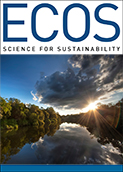
|
Published: 8 December 2014
Australia's warmest-ever spring, and prospect of ‘moderate’ El Niño
In a Special Climate Statement issued last week, the Bureau of Meteorology (BoM) reported that spring 2014 was Australia’s warmest on record.

|
|
The Bureau of Meteorology's ENSO Tracker is currently at ‘alert’, indicating at least a 70 per cent chance that El Niño will be declared in the coming months. Credit:
CSIRO/scienceimage
|
Mean temperatures were 1.67 °C above the 1961–1990 average – the largest such departure from the long-term average since national records began in 1910.
The statement also noted that many seasonal records had been approached or set over the period September–November 2014. For example, Australia had its warmest October day on record, with a 36.39 °C national mean maximum temperature recorded on 25 October.
In a separate ENSO (El Niño–Southern Oscillation) update, BoM reported that national climate indicators remain close to El Niño thresholds, with climate model outlooks suggesting further intensification of El Niño.
BoM stated that its ‘ENSO Tracker status is currently at “alert”, indicating at least a 70 per cent chance that El Niño will be declared in the coming months’.
‘Whether or not an El Niño fully develops, a number of El Niño-like impacts have already emerged. Several ENSO indicators are currently close to, or exceed, El Niño thresholds.
‘These include tropical Pacific Ocean temperatures, which have now exceeded El Niño levels for one month, and the Southern Oscillation Index, which has remained at or near El Niño levels for three months.
‘If an El Niño is established, models suggest it will be weak, or moderate at most. Regardless of whether an El Niño is declared, El Niño-like effects are likely, as shown by the Bureau’s December–February Climate Outlook, which shows a drier and warmer summer is likely for many parts of Australia.
‘Some El Niño-like impacts have already been seen this spring in Australia and several regions around the globe, including Asia, South America and southern Africa.’
Meanwhile the UK’s Royal Society has just released a report entitled Resilience to Extreme Weather, which includes new maps showing the combined impact of climate and demographic changes across the world on the exposure of people to extreme weather.
The report’s highlights include:
-
Increasing population in areas exposed to extreme weather events will exacerbate the risks from floods and droughts in many regions, but especially East, West and Central Africa, India and South-East Asia.
-
Over-65s are one of the groups most vulnerable to heatwaves, a demographic sector that is also increasing in many developed countries. By the end of the century, the combination of climate change and population change could lead to more than 10 times the number of annual heatwave exposure events currently suffered by over-65s.
-
Changes in temperature and humidity could result in significant reductions in ability to work outdoors across much of Africa, Asia, and parts of North, South and Central America. This would impact rural communities and food production for a growing global population.
Sources: BoM & Royal Society



